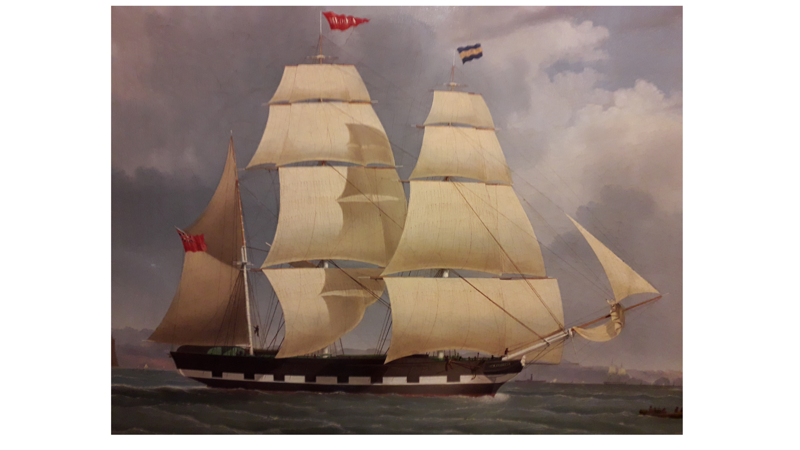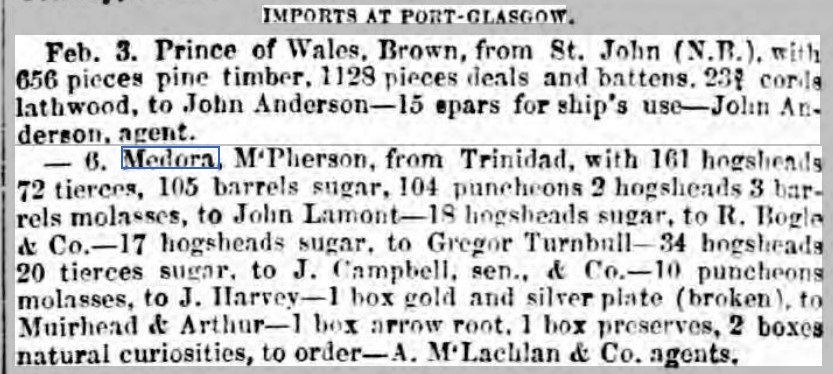The Medora – a Glasgow sugar ship

The Barque ‘Medora’ off Greenock, artist unknown, circa 1840-1850. The sailing barque Medora carried sugar from Trinidad bound for the tables of Britain
3308
Images © CSG CIC Glasgow Museums Collection
8th February 2021
Sugar was the sweetest product that came from the slave plantations of the Caribbean. It was the source of many of the fortunes made by Glasgow merchants and became a ubiquitous condiment on dining tables across Britain.
It came from the sugar cane plant, which grew well in the hot and humid climates of the islands in the Caribbean. Growing and harvesting sugar was harsh and dangerous work, and thousands of enslaved African people were transported to this part of the world to work the plantations.
After its manufacture the sugar was transported to Scotland in vessels like the Medora. The Medora was a sailing barque built in Sunderland, England, in 1838. A year later it was purchased by Scotsman John Lamont of Trinidad to transport his sugar products to the Clyde. Lamont was born in 1782, an illegitimate son of James Lamont of Knockdow, Argyll, and Isabel Clerk. Due to his situation he was not in line for inheritance and chose to seek his prospects elsewhere. Lamont moved to Trinidad by 1802 and was initially employed as a plantation overseer. Over the next thirty years he was able to purchase several plantations and became the second largest owner of enslaved Africans on the island.
After the passage of the Slavery Abolition Act in 1833 that emancipated the enslaved peoples of the British Empire, Lamont applied to the government compensation scheme for the loss of his property. In August 1834 he was awarded £17,000 for almost 400 enslaved people. The enslaved people received nothing. Lamont continued to live and work in Trinidad, invested in his growing estates and in 1839 purchased the Medora to transport his sugar. Lamont operated a shipping office in Glasgow and made several trips back to the county of his birth during the 1840s on his barque. He purchased the Benmore Estate in Argyllshire in 1848. If he intended to retire there his plans were cut short by his death in 1850.
This oil painting of the Medora was donated to Glasgow Museums in the 1970s by a descendant of John MacPherson, who captained the barque in the 1840s. It shows the Medora off the port of Greenock in full sail, at either the end or start of one of its trans-Atlantic voyages to Trinidad. It made several such round trip voyages a year taking manufactured goods from Scotland to the Caribbean. The Medora was just one of many such ships transporting the products made by enslaved or former enslaved peoples across the Atlantic to Britain.
 The cargo listing from the Medora after its arrival at Port Glasgow in February 1844 (Greenock Advertiser, 10 February 1846)
The cargo listing from the Medora after its arrival at Port Glasgow in February 1844 (Greenock Advertiser, 10 February 1846)
The history of the painting is murky. The artist is unknown and the trail of ownership is also a mystery. Though it was handed down through the MacPherson family it may have originally been commissioned by John Lamont for himself or as gift for his long-serving captain. It is a physical reminder of the connection between Glasgow and the Caribbean, where hundreds of thousands of enslaved Africans were transported. When they were eventually freed they saw none of the compensation payments paid to their previous owners and continued to work in harsh conditions on the plantations.
John Messner,
Curator Transport and Technology
Find out more about John Lamont in the excellent paper by Dr Stephen Mullen John Lamont of Benmore: a Highland planter who died ‘in harness’ in Trinidad
Find out more about the compensation paid to slave owners on the Legacies of British Slave Ownership website produced by the University of Central London.
